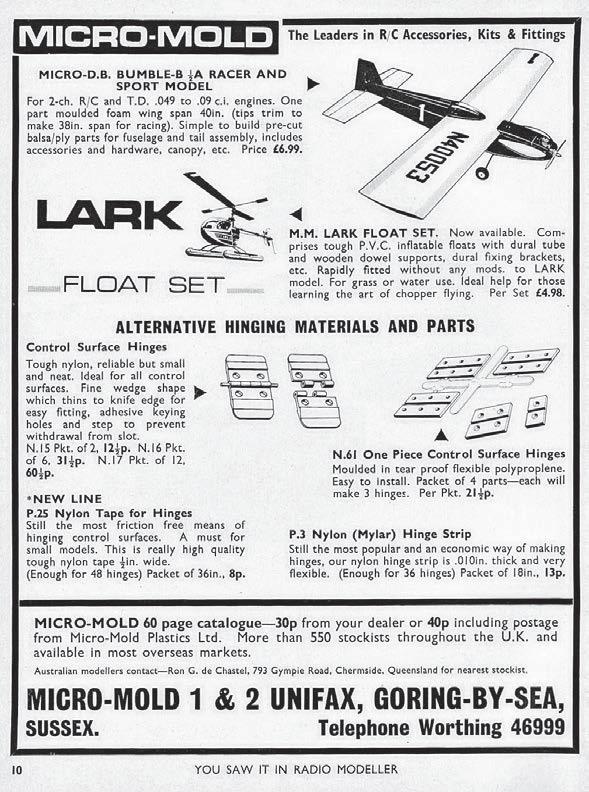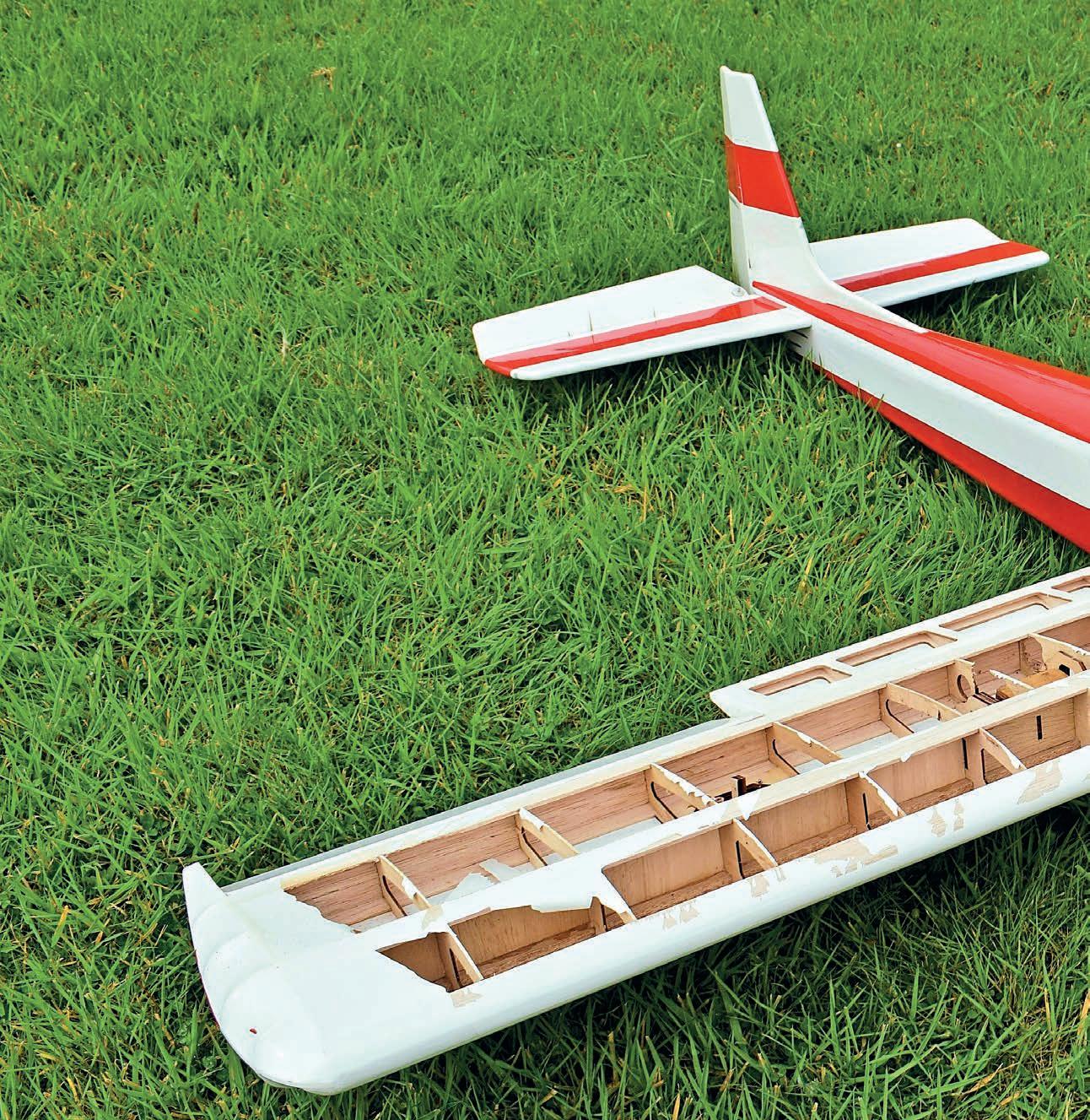
6 minute read
HOOTS MON!
Shaun Garrity buys a secondhand model and finds ‘…a mouse loose aboot this hoose’ words & photos »
Geoff, a fellow club member, had decided he needed to unload some of his gliding fleet. So never one to miss a potential bargain I went round to see what was on offer. After delving through the pile of gliders and kits in his workshop a deal was done. But just as I was leaving, I noticed a Graupner ARTF Kwik Fly 3 sitting up in the rafters. I’ve been after one of these for several years and, even better, it was for sale.
The fuselage came down first and other than a lot of dust and some slackened off covering film it looked in great condition. Grabbing the wing I noticed the rubber tyres looked like they had been subjected to a hard life on tarmac or concrete runways, with lots of pieces missing, but other than that the lower covering was in good condition. Turning the wing over told a different story, however. I noticed a red trim panel was lifted and on closer inspection, there it was - a mouse nest in the wing. Said mouse had obviously vacated casa Kwik Fly but it did me a favour as the price suddenly and significantly dropped. Pulling out the nest cleared up the mystery of the wheels as lots of nibbled bits of tyre were scattered in the wing. Strangely, on removing the top covering film the mouse obviously had delusions of grandeur, wanting to extend its property empire and had nibbled its way to the other wing tip, seemingly having a particular liking for the top spar and shear webbing.
The good news is the rodent vandalism can easily be repaired with an hour or two of effort and I’ll have the Kwik Fly 3 airworthy and back in the sky very soon. That is when I’ve located a very weird shaped fuel tank and a motor mount with an extremely odd bolt pattern. Oh, and found a suitable two stroke motor!
I think Geoff’s next purchase should be a shed cat to protect his remaining model fleet.
Currently a ‘Not So Kwik Fly 3’, but it won’t take long to fix Mickey’s vandalism and have this classic airframe back in the air.
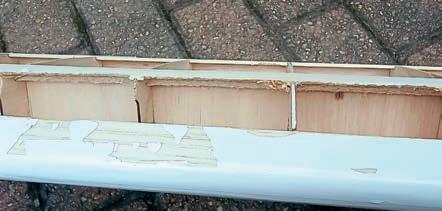

4. But the other side had some major tooth inflicted modification to the spars and shear webbing.
5. Mickey was obviously keen on some significant remodelling in his new house, attacking these ribs as well.
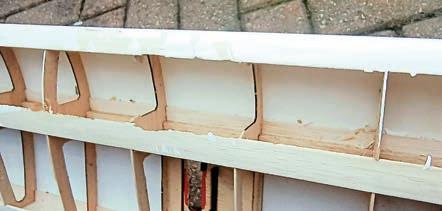

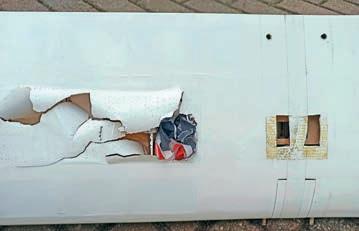
More Willard Wonders
Deciding to have a bit of a clear out myself, I started going through all my models employing a simple rule: if I hadn’t flown it in the past five years or so then it was time to move it on.
I came across what I thought was a McCutchen wing. Also known as a Charybdis (the name of a whirlpool between Italy and Sicily), this strange looking flying plank is essentially a single blade free flight helicopter; the only moving part is the engine. The original design by Charles McCutchen was published in July 1954 Aeromodeller and was no doubt inspired by Charles watching a sycamore seed ‘wing’ its way to the ground.
A quick look at the accompanying plan will clear things up but essentially Charles described it as:

‘
A wing and motor on opposite ends of a boom with a weight on the end of a stick to put the Centre of Gravity ahead of the leading edge and to ensure that the moment of inertia is largest about the axis perpendicular to the wing.


In flight the wing sweeps out a cone and the balance arm, owing to centrifugal force, is nearly horizontal. When the engine is running the gyroscopic precession of the propeller raises the balance arm above the horizontal position, giving the wing a positive angle of attack. The thrust from the engine keeps the whole machine rotating and it climbs. When the engine stops the angle of the wing and balance arm falls below the horizontal and the machine autorotates down to the ground.’
Charles found that not all configurations were stable but fortunately due to a good understanding of aerodynamics and lots of experimentation he cracked it. If you want chapter and verse on the theory of this odd ball flying machine, I would suggest tracking down a copy of the original article.
Anyway, my particular wing had been given to me a number of years ago and I always assumed it was a McCutchen. But on researching Ken Willard designs last month I came across the Rotoriser and realised my Charybdis was actually Ken’s version. I would love to be able to fly it at our field, but free flight isn’t allowed as it’s a public space. If you ever attended the BMFA Nationals at Barkston Heath, it was common to see a number of these whirling dervishes heading skyward in the evening ‘chuck and duck’ sessions. I have seen a You Tube video of a modeller who’s made an electric powered Charybdis, with an R/C throttle to enable a modicum of controllability. Maybe that’s the future and it will certainly sort out any carburation and fuel feed issues. This one I’m keeping, so the rule breaking had already started.
Another model I extricated was the Das Ghosten Flugboot. I covered it in RCM&E, December 2016. Originally designed back in 1970 by Derek Walton, this flying boat was novel for a number of reasons and used Galloping Ghost with a home-made actuator. Again, whilst looking through Ken’s back catalogue, I came across his Shearwater design from 1967 and it’s not hard to see where Derek got his inspiration from for his flying boat.
BUMBLE-B
Back in the late 1960s and early 1970s there was a range of quick build kits designed by David Boddington for single or two channel. They featured a moulded 40” injection moulded foam wing that was common to the range: Kestrel, Nipper, Flapper, Planet and Bumble-B. These kits were manufactured and distributed by Micro-Mold.
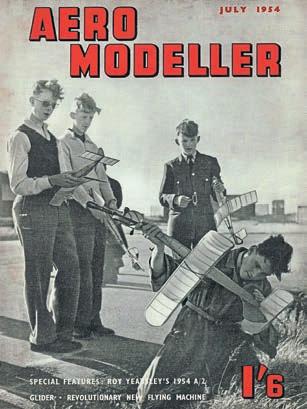
All but one had traditional balsa/ply fuselages, with the Kestrel featuring a moulded ABS fuselage. These kits were low cost and provided an easy way to get skyward as the wing was essentially ready finished. In fact, it didn’t even need covering.

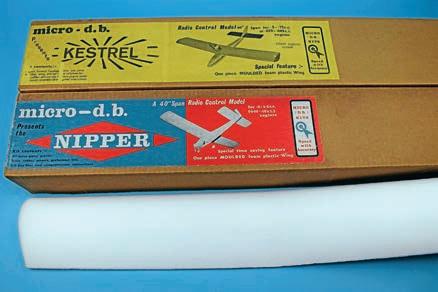
The Kestrel glider was an updated version of a traditionally constructed model designed previously by Dave. Nipper was essentially a Ghost Rider look alike, while Flapper was clearly influenced by the Barnstormer, Planet a sort of Craftsman and the Bumble-B a midwing 1/2A racer similar to the Ghost Racer and Emperor. The recommended power range was 0.049 to 0.09 cu.in., the exception being 0.020 to 0.049 for a power pod option on the Kestrel. Cox TD’s or even the humble Babe Bee would have them zipping around the sky.
Last year I managed to pick up a Kestrel kit. I had been after one for a long while as this little model caused me some serious grief many years ago and there was a score to settle…
I’ll explain. I’d managed to dislocate my shoulder and after a month of recuperation I went flying. On arriving at the field, and being the first there, I set up the model, fired up the little Cox and checked the radio – all good. With virtually no wind that day I gave it a hefty lob skyward. This is where things went sideways quickly because my arm decided it wanted to try to follow the Kestrel and dislocated again. Having no throttle on the Cox the next five minutes was the least enjoyable flight I’ve ever experienced and, adding insult to injury, the fuselage broke on landing - a salutary lesson in why not to fly solo.
Anyway, many years on I now have the opportunity to enjoy what the plane was designed to do. Unfortunately, I dislocated the same shoulder a month ago after a fall. Maybe this is a cursed model that I should forget about!
I have a request. Does anybody have a Bumble-B kit sat in the loft that will never get finished. The reason I’m asking is I want to build one. I’ve even called Dave’s son, Andrew to see if he had the plan, as I have a few of the Micro-Mold wings, but unfortunately he hasn’t. So, if you have one, please contact me so I can arrange to get a copy.
1/2: Comparing plans, you can see Flugboot was a very similar design to the earlier Shearwater, which was an uncomplicated flying boat. Ken Willard designed a number of these aquatic wonders.
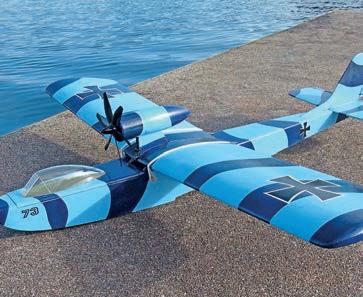
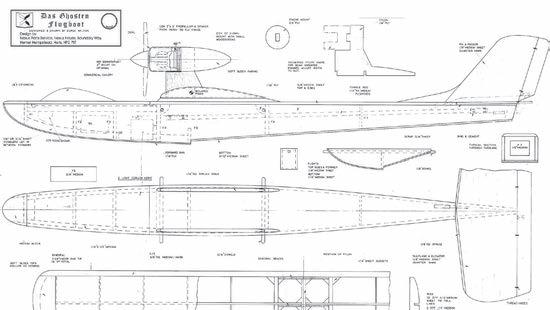

3: I’ve had a lot of fun with my Das Ghosten Flugboot.
4: I have a few in the build pile. The one-piece injection moulded wing seen in the foreground was common to the range,
5: Micro Mold had a vast range of modelling related products and produced some interesting kits besides the Bumble-B that I’m after. The Lark helicopter introduced many modellers to rotary flight.
